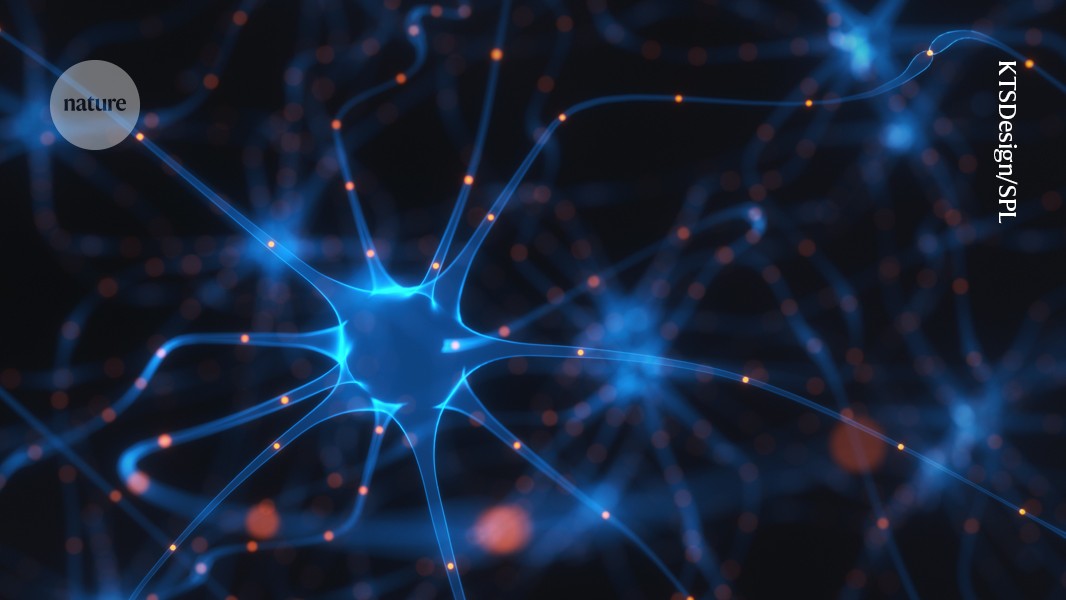
Neurons (artist’s illustration) that affect hunger lose their ability to sense insulin when encased by a sticky scaffolding.Credit: KTSDesign/Science Photo Library
A build-up of sticky goo that traps neurons in an appetite-control centre in the brain has been implicated in worsening diabetes and obesity, according to research on mice1.
The goo also prevents insulin from reaching brain neurons that control hunger. Inhibiting production of the goo led mice to lose weight, experiments found. These findings points to a new driver of metabolic disorders and could help scientists to identify targets for drugs to treat these conditions.
These results were published today in Nature.
Hunger dial in the brain
Metabolic diseases such as type 2 diabetes and obesity can develop when the body’s cells become insensitive to insulin, a hormone that regulates blood-sugar levels. Scientists searching for the mechanism that causes this insulin resistance have homed in on a part of the brain called the arcuate nucleus of the hypothalamus, which senses insulin levels and, in response, adjusts energy expenditure and sensations of hunger.
As the animals develop insulin resistance, a type of cellular scaffolding, called the extracellular matrix, that holds the hunger neurons in place becomes a disorganized goo. Previously, researchers had noticed that this scaffolding changes when mice are fed a high-fat diet2.
Milkshake neuroscience: how the brain nudges us toward fatty foods
The researchers wanted to see whether these brain changes might drive insulin resistance rather than merely developing alongside it. The authors fed mice a high-fat, high-sugar diet for 12 weeks and monitored the scaffolding around the hunger neurons by taking tissue samples and monitoring gene activity.
They found that this scaffolding became thicker and stickier within weeks of the mice starting the unhealthy diet. As these animals gained weight, their hypothalamus neurons became less able to process insulin normally, even when the hormone was injected directly into their brains. This suggests that the scaffolding’s stickiness stops insulin from getting into the brain. Instead, “it gets stuck”, says co-author Garron Dodd, a neuroscientist at the University of Melbourne in Australia.
Goo loss leads to weight loss
To try to reverse these changes, the researchers injected mice with either an enzyme that digests the goo or a molecule called fluorosamine that inhibits the scaffolding’s formation. Both approaches successfully got rid of the sticky logjam in the animals’ brains, allowing for increased insulin uptake. Fluorosamine even led the animals to shed weight and increase their energy expenditures. Treating insulin resistance by targeting the support structure around neurons might be safer than targeting neurons directly, Dodd says.
These brain cells could influence how fast you eat — and when you stop
This “high quality” study proves “again and again” that this cellular scaffolding regulates hormonal signalling in a way that directly affects the rest of the body’s metabolism and drives disease, says Kimberly Alonge, a biochemist at the University of Washington School of Pharmacy in Seattle, who was not involved with the study. It also directs the field to focus not only on individual cells and cell types, but also the “packing material the cells are sitting in”, she adds.
The team’s experiments also showed that inflammation in the hypothalamus drives disruption of the scaffolding, but the study does not address what causes the inflammation to begin with, Alonge says. Previous research has shown that brain cells called glia can affect the structural integrity of the scaffolding, and Alonge would like to know whether glial cells contribute to the inflammation observed in the study.
It’s still unclear how big a part dysfunctional scaffolding plays in causing metabolic disease compared with other well-established drivers of disease, Dodd says. He and his colleagues hope to address this question later.
Future research is needed to investigate whether this goo arises as humans develop metabolic disease. This might pose a challenge, Dodd says, because there is no non-invasive way to access the hypothalamus, which is situated deep in the brain, and it’s a difficult tissue to sample, even from donated organs.




